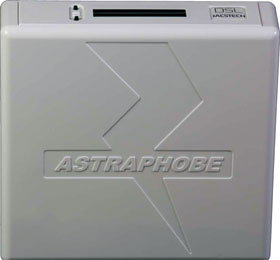Smart lightning protector for ADSL lines
20 May 2015
Electronics Technology

A South African inventor has developed a device that takes an unusual approach to protecting DSL lines from damage due to lightning strikes.
The Astraphobe DSL (astraphobia is the abnormal fear of lightning), made by Jorgen Nielsen’s company Jacstech, automatically detects lightning and disconnects the ADSL and telephone lines. When the storm moves away, the device reconnects the line, ideal for homeowners in lightning-prone areas like Johannesburg – which is exactly where it was developed and tested during the 2013 storm season.
Explaining the need for such a device, Nielsen says “Until now, homeowners in lightning-prone areas have had to learn the hard way that the only method of protecting equipment in a storm is to unplug it. But even if you’re home, doing so is a hassle and when you’re out, it’s simply not possible to perform this manual intervention. That leaves equipment dangerously exposed.
“Nobody likes inconvenience, especially not the Internet generation. Ease of access is everything and as a result, our lines tend to stay connected at all times. If you’re away and a storm rolls in, your router and any other equipment connected to it can be zapped even if there is a surge protector on the power supply.”
That’s because the powerful surge of electricity from a lightning strike can travel down the ADSL and telephone lines, destroying sensitive equipment. Since ADSL lines are typically connected directly to the router and onwards to printers, computers, games consoles, storage systems and other devices, the amount of damage that can be caused by a lighting strike is substantial.
ICASA approved and patent-pending, the Astraphobe can be configured by users through a computer interface, and maintains activity logs. It can identify approaching weather at distances up to 40 km and is good for over 180 000 connect/disconnect cycles, which is the equivalent of over 300 years of continuous operation in a storm-prone area.
For more information visit www.astraphobe.com
Further reading:
140 W USB-C PD reference design
Altron Arrow
Electronics Technology
The design has a wide input range of 90 to 264 V AC, 50-60 Hz, and supports an output voltage range of 5 to 28 V (USB-PD 3.1 specification).
Read more...
Nanometre-precision piezo actuators
RS South Africa
Electronics Technology
TDK Corporation has announced two new piezo actuators that are characterised by a wide dynamic range, a high force-to-volume ratio, but with precision in the nanometre range.
Read more...
Webinar: The evolving electrification of the power distribution system
Electronics Technology
New connected car functionality, along with the necessity to reduce the cost, weight and complexity associated with wire harnesses, has led to the transformation of the power distribution system in automotive engineering.
Read more...
Improved MnZn material for power conversion industry
Sivan Electronic Supplies
Electronics Technology
Cosmo Ferrites Ltd, a leading manufacturer of soft ferrites, has launched an improved version of CF295 for the power conversion industry.
Read more...
Common mode filter for automotive Ethernet
Avnet Abacus
Electronics Technology
TDK Corporation has announced the introduction of its new ACT1210E Series common mode filter for automotive Ethernet 10BASE-T1S.
Read more...
Energising the industrial edge
Electronics Technology
As if the drive to decarbonise energy as part of sustainability and climate change efforts was not enough, the recent rise in energy prices has brought into sharp contrast the need to re-examine how we generate, distribute, and consume electricity.
Read more...
Samsung begins chip production using 3 nm process technology
EBV Electrolink
Electronics Technology
The optimised 3 nm process with GAA architecture achieves 45% lower power usage, 23% improved performance and 16% smaller surface area compared to 5 nm process.
Read more...
Panasonic releases its updated touch-sensitive knob
Altron Arrow
Electronics Technology
Panasonic, in conjunction with Microchip, has launched an update to its existing Magic Knob, a capacitive knob ready for standard touch sensors for use in controlling automotive information displays.
Read more...
Microchip’s new IC to replace Hall effect position sensors
Altron Arrow
Electronics Technology
The LX34070 IC from Microchip is set to help accelerate the global move away from expensive and less accurate magnet-based solutions for safety-critical EV motor position monitoring.
Read more...
A brief history of HBTs
Conical Technologies
Electronics Technology
In 1947 the engineers at Bell Labs were tasked with developing a transistor. This development heralded the beginning of the semiconductor industry which changed the world forever. Transistors would have
...
Read more...


